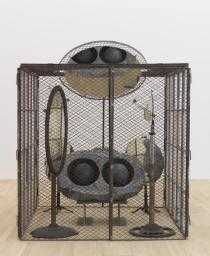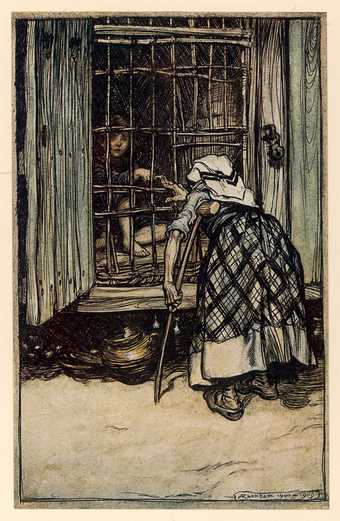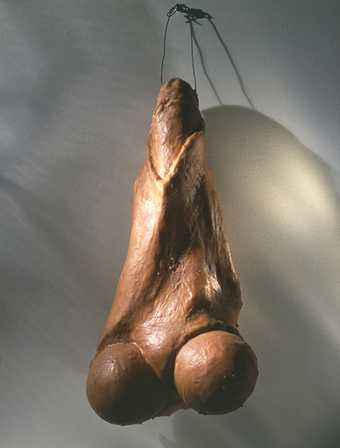A spring afternoon in New York and I have an appointment at Louise Bourgeois’s home at three o’clock, with a view to completing an interview already carried out by correspondence. However, the fax from her assistant Jerry Gorovoy says explicitly: ‘Come on Sunday at 3pm just to say hello, no questions please.’ This is not ideal, but I don’t want to miss my opportunity to meet the great artist, as I’ve come from France to see her. At the specified time I arrive, with a friend, at the house, one of a row of modest early twentieth-century brownstones. It is immediately recognisable from the latticed ironwork door made by the artist. This opens and I’m surprised by the presence of other people, some of them holding enormous bouquets of flowers. I feel a bit silly with my modest bunch of daffodils, bought in honour of the host’s country of origin, France, where they grow wild. We greet the little group and climb the stairs. Suddenly a woman skips out, her short floral skirt spinning, whirling like a dervish. Is this Louise’s housekeeper? She takes my daffodils and throws them with the other bouquets on a kitchen table where they will stay, without water, for the rest of the afternoon. The group follows her down a narrow corridor towards the room that serves as drawing room, library and studio. I don’t have to ask if my friend is welcome. Louise is sitting with her back to the light, elbows on a table, by a door that opens on to the kitchen. She greets us as we pass, as if she were a schoolmistress receiving her former pupils. She is dressed in black and looks a bit like a refrigerated bird – her waistcoat put on inside out, dangling legs ending in girls’ black patent leather shoes. To my surprise, her handshake is soft, though her eyes study us like an eagle gauging the weakness of its prey.
The guests take their seats in a semi-circle on a sofa and un-matched chairs. The only light comes from two windows covered with condensation, through which I can just make out a garden cluttered with objects. One of the walls of the room is covered by shelves over-flowing with dusty books, while the opposite wall acts as a notice board. Loosely pinned to it are sketched for exhibition posters, press-clippings, ragged sheets of paper and photographs.
Louise is visibly nervous. She calms herself down, eating truffles from a box. She asks what the time is, then immediately launches an attack on the only man present – an Asian. He proudly holds a huge roll of paper in his hand. ‘Who are you? Why are you here?’ asks Bourgeois with a force so brutal that I freeze. As he mumbles his name, a woman comes in noisily, clutching a camcorder and tripod, then exits. Louise rebukes her for being late. She turns back to the man: ‘What did you bring with you to show us?’ He gets to his feet and unfolds a vast charcoal portrait of the artist Bram van Velde. ‘But why did you bring that drawing?’ she asks. He says he wants to do her portrait. She asks him where he’s shown before. When he tells her that he took part, with van Velde, in an exhibition at the Museum of Modern Art in 1964, she interrupts, saying: ‘It’s not true!’ With one last try, the man asks if he can take her photograph. ‘No! You are a painter, you can draw me.’ The man, piqued, rolls up his drawing, gets up and leaves.
I prepare my own reply to the question of why I am there, but it will transpire that me and my friend will be the only two mute witnesses to this gathering. The filmmaker returns and asks us if we would like a drink – Coca-Cola or cognac. Everyone opts for Coca-Cola except one young woman. The filmmaker carries out some lighting tests. What’s happening? Are we going to be filmed? Is that why we’ve been invited, or is this a sequence for a new film on the artist? The young woman with the cognac sits on Louise’s right. ‘So, who are you and why did you come?’ asks Louise. ‘My name is Jack Ox,’ she says. ‘I am an artist.’ Bourgeois replies: ‘What kind of name is that?’
‘An artist needs an interesting name and I chose Jack Ox, which in French translates as Jacques LeBoeuf. It’s funny, isn’t it?’
‘I don’t think it’s funny at all,’ comes the reply. ‘So, what do you do? Did you bring anything with you?’
The woman tries to explain that she plays with sounds, puts music into colours. She talks about resonances and consonances. Louise cuts short her explanations and asks her to play the xylophone. ‘But I can’t play the xylophone.’
‘What do you mean,’ she exclaims, ‘you’re a musician. Any child can play the xylophone!’
Louise then persuades her to sing. Jack Ox begins to emit sounds which, according to her, correspond to a scale of colours. Meanwhile, the camera is rolling. It all feels rather surreal. As Jack gains her confidence, Louise asks us: ‘What do you think about all this? Is it fake, or is it serious?’ She does not allow time for the assembly to react, but asks the daughter of a famous American gallery owner, who she seems to know well, to read her poems. The girl’s voice is frail. Louise scolds her: ‘We can’t hear anything. Louder!’ And the girl, even though she’s intimidated, tried to project and manages, as though by magic, to do so. Louise seems to appreciate it…
Night falls, and Bourgeois finally frees us from our long afternoon, which was more like a group therapy session than a meeting with the artist, But despite the tensions and vexations, it is with regret that we leave this strange salon, this cell that bears the imprint of Louise’s bittersweet oeuvre.



